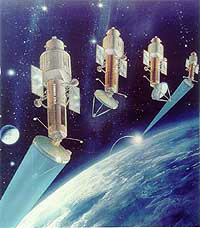 |
 |
 |
 Technology News | May 2005 Technology News | May 2005  
US Weapons in Space
 The New York Times The New York Times


| | U.S. Air Force depiction of deployed Space-Based Laser constellation. |
The Air Force is pressing hard to develop defensive and offensive space weapons without adequately considering the potential adverse consequences. At this point, it is not clear whether Air Force aspirations for these weapons are mostly technological fantasy or have some real hope of success. It is certainly true that the Air Force wants to achieve and maintain military superiority in space. "We haven't reached the point of strafing and bombing from space," an Air Force official said last year. "Nonetheless, we are thinking about those possibilities."

Already, the Air Force has spent billions of dollars on its effort to develop space weapons, with little public discussion. Now, as an article by Tim Weiner of The Times revealed last Wednesday, the Air Force is seeking a presidential directive that could strengthen military uses of space.

Currently, space satellites serve important military roles but only in support of ground operations. American forces rely heavily on satellites for communications, global navigation, location and tracking of targets, and collection of intelligence. If an enemy managed to disrupt these in a time of conflict, American forces would lose one of their great advantages, so it is reasonable for the military to seek ways to protect its satellites from harm or else lessen reliance on them and compensate for their loss.

What the Air Force has in mind is shrouded in secrecy and euphemisms, but some sense can be gleaned from an array of programs described by Mr. Weiner. An experimental microsatellite launched last month has the technical ability to disrupt other nations' military satellites. A proposed global strike space plane would carry munitions halfway around the world in 45 minutes. The "Rods From God" program would hurl dense metal rods at targets on the ground with the force of a small nuclear weapon. Other programs would use laser beams or radio waves to disable targets.

This all sounds similar to the technological hubris shown by missile defense planners, who started out with grandiose Star Wars designs two decades ago. Now, $100 billion later, they still can't reliably detect and destroy an incoming missile. Nobody knows how well the new weapons might work, and there is concern, even in military circles, that basing weapons in space might trigger an arms race that would leave the United States, with its undeniable advantage in conventional forces, worse off than it is now. Another problem is cost. With virtually all weapons systems busting their budgets, the Pentagon should think hard before putting hundreds of billions of dollars into new space technologies.

Congress and the administration need to assess whether a multilateral treaty to ban space weapons might not leave the nation far safer than a unilateral drive to put the first weapons in space. | 
 | |
 |



